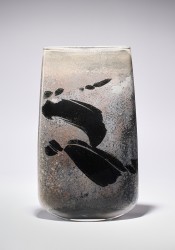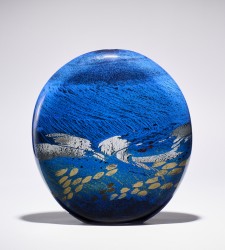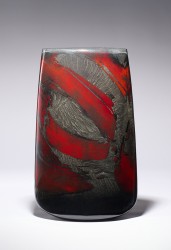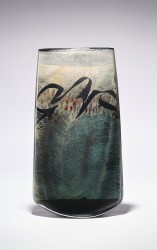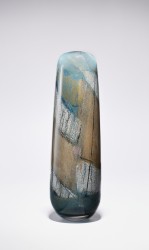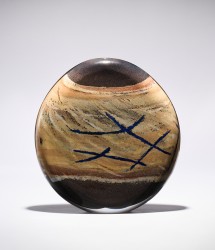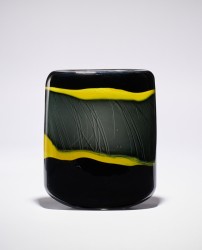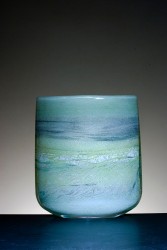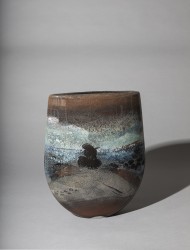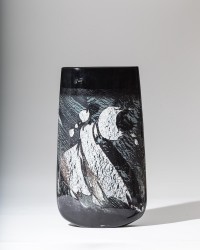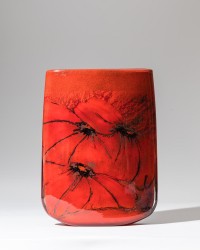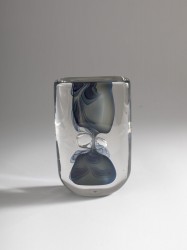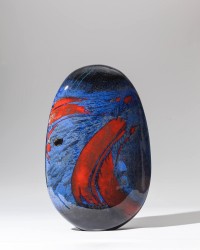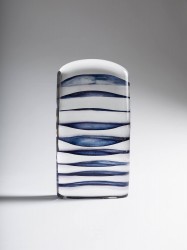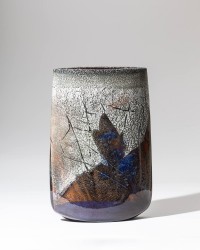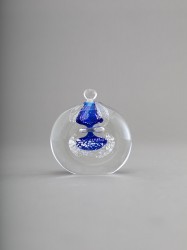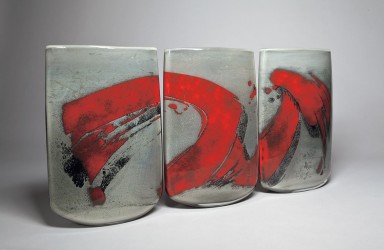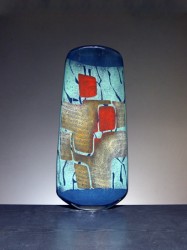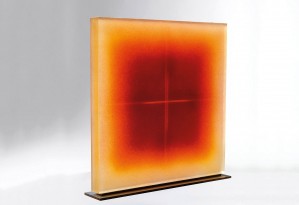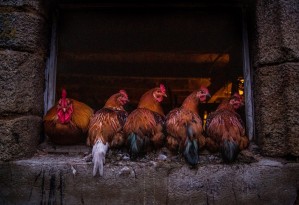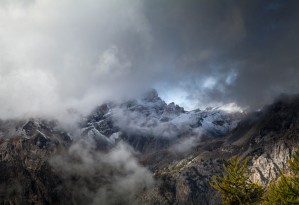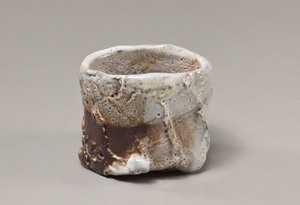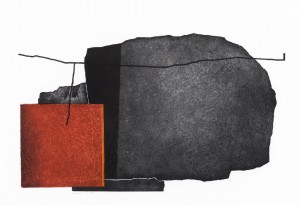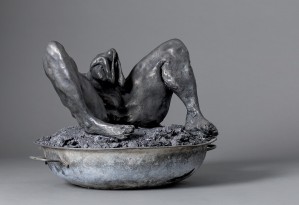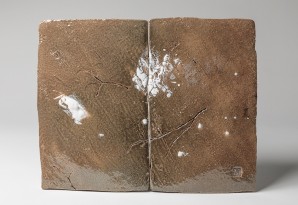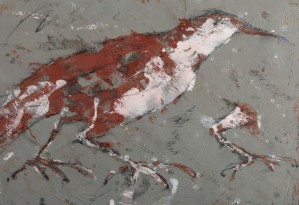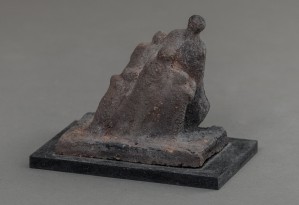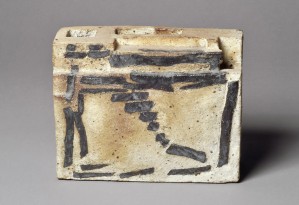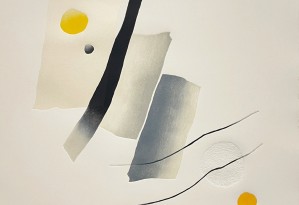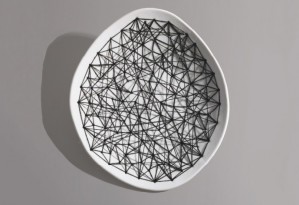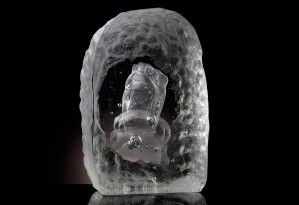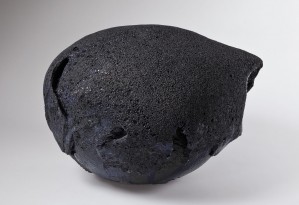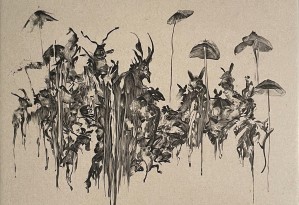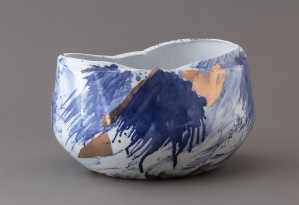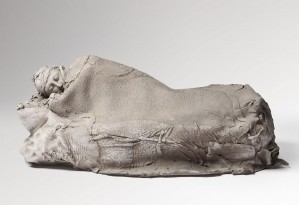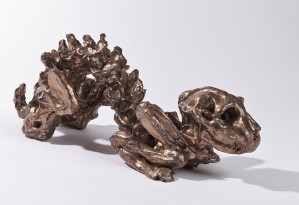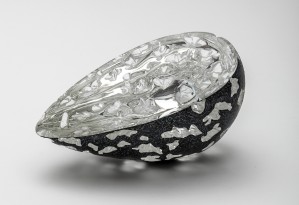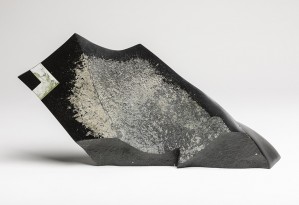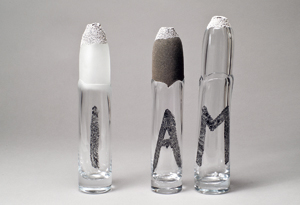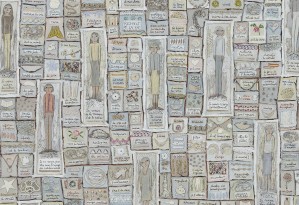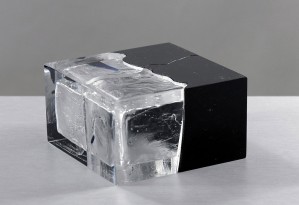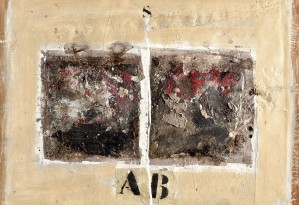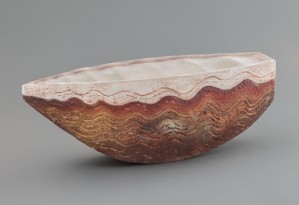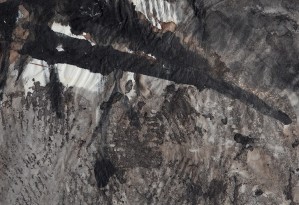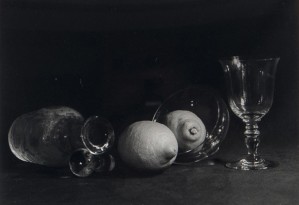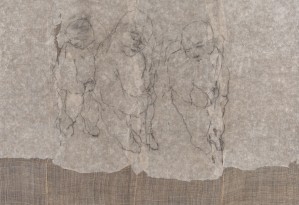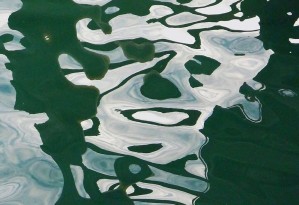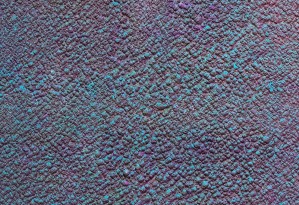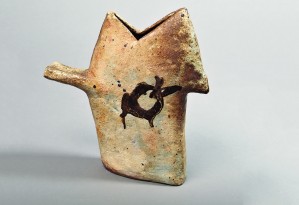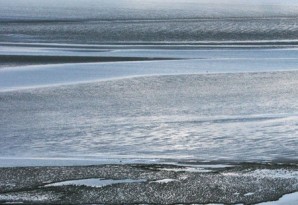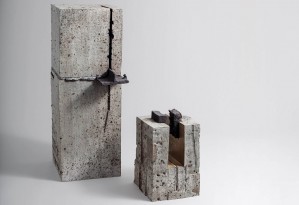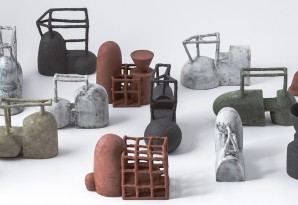BEGOU Marisa et Alain, glass, blown glass, permanent artist of Galerie Capazza since 1995
“Marisa and Alain Bégou constitute a completely self-sufficient microcosm within the varied world of artists who have elected, always with a highly personal approach, to use glass as their means of expression.
Their work is, in fact, entirely the fruit of their own labour, from the moment of its conception to the finished product. It leaves their hands, both metaphorically and literally the result of a symbiotic process that unites the two artists in both life and work yet leaves each clearly defined operational role.
Marisa’s task is to devise and compose the decorative motifs and it is up to Alain to incorporate them into each work, to transform the always different assemblies of vitreous materials into pictorial expanses of extraordinary richness and depth.
In essence, their work takes place in two stages. Marisa, operating completely independently, builds up the form and colour of the decoration with a variety of glass powders and fragments, arranging them on a metal plate almost as if it were a sheet of drawing paper.
The plate is then heated and Alain skillfully and quickly rolls the gather of molten glass attached to the end of his blowpipe over the colour composition so that it adheres to and amalgamates with the glass, which is then ready for further working.
The process may sound simple but at every turn something can go wrong that may irremediably compromise the success of the work. It is a question of judging time and movements with absolute precision: too brusque a gesture or just a few seconds’ delay can be fatal.
The problems may arise even before the working process begins. A decoration may appear at first to refuse to meld with the glass but Alain’s years of experience in the Biot and Allex glass factories in the Drôme area enabled him to develop and perfect ways of overcoming every difficulty, of imposing his will over a material which is at best mercurial and sometimes downright treacherous.
The presence of works by the Bégou’s in Venice, at the first “Aperto Vetro” in 1996, introduced them to an Italian public that almost always tend to indentify furnace-made glass with Murano.
Since their début, their work has made its mark not only because of its technical originality, the result of Alain’s superb skills, but also for the singular chromatic harmony of the textures, capable of evoking nature’s most vivid colors and their infinite range of shades.
In their love and respect for glass, Marisa and Alain avoid strange, pointlessly complex forms in favor of simple, linear silhouettes that enhance the innate characteristics of the material and release its full expressive potential.
Thus it is that their creations always evince a clear spirit of research and a sense of progressive, constant evolution in which the size of their wors, that have gradually become more and more imposing, has assumed an almost symbolic significance.
With their almost constantly repeated shape, the works become like great idols emanating multiple-layered messages concerning nature, abstraction or cryptic scripts, which lend themselves to different, personal interpretations.
As works of art, in short, they offer the viewer various approaches to meaning, each one as valid as the others.
In addition, they engage in an intriguing, even ambiguous game with the viewer : in their actual, massive, three-dimensional reality, they resemble fine, airily elegant pages covered with magical, mysterious writing, an invitation to explore, discover and interpret, utterly conventional and unconditional.
Marisa and Alain live and worked in the atelier they established in 1979 and where they share their unreserved passion for glass”
Attilia Dorigato, Curator of the Glass Museum in Murano, Italy
“The creation of blown glass is almost never the work of just one person, and in fact, the pieces are the product of complementary skills and close collaboration of two artists working in an independent studio.
Having discovered an affinity with glass at the Biot glass factory in the 1970s, Alain first learned the blowing technique in a utilitarian context and then set up a studio in partnership with is wife Marisa when she began to contribute her skills as a decorator and colorist.
The artistic intimacy that now informs the conception and creation of each unique piece developed gradually during the 1980s. So their originality is the hard-won result of a long and rigorous apprenticeship.
For several years now, their style has been marked by a formal, sober, monumental simplicity set off by the subtly chosen colours of the decorative scheme.
These colored surfaces generally emerge from an opaque ground, their edges just faintly outlined by the last overlay of clear glass, a pared down and personal interpretation of Venetian “sommerso” glass.
Their taut curves and upward thrusting contours give these imposing monoliths of blown glass a confident elegance.
The principle of a dual faced object, an original, even unique, solution for pieces of this size, enhances the decorative features conceived in this perspective.
The decorative themes, both abstract and narrative, are explored with the use of powdered pigments that have been subjected to an exhaustive process of manipulation and experimentation, testing how they react in the furnace, whether their aesthetic impact and chemical composition change or hold fast. The powdered colors are laid out on a metal plate and adhere to the gather of molten glass as it is rolled over them, before melding and merging on and under the layers of glass as they fuse.
The extraordinary effects thus created positively invite the eye’s exploration but yield nothing to the touch. For me, the fascinating essence of the Bégou’s work lies in the exasperating paradox of the enticingly tactile depth of color and the cold smoothness of the real surface.
They interpret changes in seasons, moments, space, moods and places as violent contrasts, subtle irradiations redolent of fabrics, sophisticated calligraphy, almost figurative images or evocations of minerals.
They work to their own rhythms and each is free to pursue a personal melody preference but every piece shares a unity based on these technical principles and these formal features.
Solid and monumental, their “vases” have a manifest generosity of spirit and subtle equilibrium that places them in the classical tradition started by Maurice Marinot in the 1920s, which subsequently spread right round the world by way of Scandinavia and Venice. A new spring welled up some twenty years ago in Languedoc, where Alain and Marisa Bégou, certainly not isolated but protected, work to the rhythm of their studio of craftsmen artists of the twenty-first century.
Jean-Luc Olivié, Curator of the Decorative arts Museum in Paris
Marisa and Alain Bégou’s workshop just outside Villetelle (Hérault, France), close by the house where they live, is a place which is like them, open and serene. Over the years, they have arranged it so that it responds perfectly to the movement of the daily duet they execute around their furnaces to produce the works they make together. Living side by side for thirty-two years, they have gradually developed a warm companionship which does away with the need for words. Alain is more talkative than Marisa who lets him start telling their story. Then, she listens, rectifies details and makes the occasional comment. Since the time when they met as ordinary workers in the Biot glass works, they have relentlessly forged a path which has taken them to the most illustrious museums in the western world. For others elsewhere, it could have seemed like a fairy tale. But for them it was synonymous with tenacity, daring and talent combined into a determination to prove that nothing is impossible for genuine creative artists. And in fact their work, which is based exclusively on the rules of glass blowing, has with time revealed itself as one of the most personal and accomplished of its kind. He says “it’s owing to her”, she says “it’s owing to him”. But one does not try to decide between them because it really doesn’t matter. Through their work they areas one, for it is the magnificent pieces which come out of their furnace that express a total mastery over matter and the sensitivity of creative imagination.
“In some instances, we realize quickly that we have made an outstanding piece. It’s something that both of us know immediately. When we see that perfect harmony of shape, color and decoration, tension levels shoot up in the workshop. We don’t say a word. We work in silence, worrying that something uncontrollable will happen before the end, in fear of a setback. The suspense is unbearable until the piece comes out of the furnace the next day. Every piece is a risk, especially the ones we are satisfied with.”
Marisa Bégou
Biography
Alain and Marisa Bégou have lived together for more than thirty-five years and are united by a common passion: the work of hot glass. A complicity that has become almost fusional that allowed them to form a real roped party. This is how they invented a method of creation adapted to their contradictory and complementary personalities.
In 1967, Alain Bégou discovered the practice of blown glass by maintaining the furnaces at the glassworks of Biot (Alpes Maritimes). A few years later, he learned the craft of blower at the utility and decorative glassware of Allex (Drôme).
In 1979, the couple Bégou opened his own workshop in Villetelle (Hérault) and Marisa spontaneously joins the creations of her husband.
Perfected by tireless research, the work of Alain and Marisa stands out quickly. In 1987, the blue-red-black vase, a small flat and opaque room with aerial colors, led the Bégou's art towards greater pictoriality.
It was not until 1994 that the Bégou found their way of definitive creation. They specialize in the use of glass powders that Marisa tames to invent sumptuous compositions.
Realized in the secret of their connivance, their works combine the perfect mastery of the material and the sensitivity of a creative imagination where nature is secretly reflected. Marisa is the designer, Alain the creator of the form and each of their pieces exalts this subtle marriage. At the rhythm of this perfectly measured four hands, the creation of one work calls for another.
Their pieces are exclusively made in the rules of blown glass and it is through this restrictive technique, too often excluded from the field of creation, that Alain and Marisa Bégou imagined a free and personal expression.
In this harmonious and lyrical work, everyone will find something to dream about ...
Angélique Escandell, November 2002
Read morePersonal exhibitions
2011 Galerie Capazza, Nançay, France
2006 Galerie Françoise Polack, Montpellier, France
Galerie Hélène et Marc Porée, Paris
2005 Glasgalerie Stadler, Linz, Austria
Galerie Capazza. Nançay, France
Galerie Etienne & Van Den Doel, Oisterwijk, Netherlands
2004 Galerie T. Rocfort, Rennes, France
Galerie Fusion Toulouse, France
Musée de Conches, Conches, France
Galerie H.D. Nick, Aubais, France
2003 Le Salon du Collectionneur, Carrousel du Louvre, Paris, France
One Man Show, Galerie D.M. Sarver, Paris, France
Château des Planches, Galerie Capazza, Saint Maur, France
2002 St’ART Strasbourg. One Man Show, Galerie D.M. Sarver (Paris), Strasbourg, France
Glasgalerie Köln. Cologne, Germany
Galerie Broft. Leerdam, Netherlands
Galerie F. Polack, Montpellier, France
2001 Verrerie du Languedoc, À l’intérieur du four, Vergèze
Galerie D.M. Sarver, Paris, France
Galerie Postaire, Lyon, France
Galerie Godar, Lille, France
2000 Galerie H.D. Nick, Aubais, France
Studio Haus Rosenthal, Copenhague. Danemark
Galerie R. Junck. Venezia, Italia
Galerie Cristel, Limoges, France
1999 Galerie J. Betton, Lyon, France
Galerie T. Rocfort, Rennes, France
Galerie D.M. Sarver, Paris, France
1998 Galerie M. Sanske, Zurich, Switzerland
Galerie H.D. Nick, Aubais, France
1997 Galerie F. Polack, Montpellier, France
Galerie D.M. Sarver, Paris, France
1996 Galerie T. Rocfort, Rennes, France
J. Betton, Lyon, France
1995 Galerie J.C. Chapelotte, Luxembourg
Galerie D.M. Sarver, Paris, France
Galerie F. Polack, Montpellier , France
Salon International d’Art Contemporain, Galerie F. Polack, Strasbourg, France
1994 982 Trasparenze d'Arte a Venezia, Galerie D.M. Sarver. Zitelle, Venezia, Italia
1993 Galerie Viguerie, Toulouse, France
Galerie J. Betton, Salon des Antiquaires, Lyon, France
Galerie F. Polack, Montpellier, France
1992 Galerie T. Rocfort, Rennes, France
Galerie J. Betton, Lyon, France
1991 Galerie Christel, Limoges, France
Galerie Place des Arts, Toulouse, France
Galerie D.M. Sarver, Paris, France
Galerie A. Laroche, Dijon, France
Galerie Kunst & Keramiek, Deventer, Netherlands
1990 Galerie F. Polack, Montpellier, France
Galerie J. Betton, Lyon, France
1989 Galerie l’Atelier, Grenoble, France
Galerie R.M., Angoulême, France
Galerie D.M. Sarver, Paris, France
1988 Galerie F. Polack, Montpellier , France
Place des Arts, Toulouse, France
Bayle-Bégou, Galerie D.M. Sarver, Aubais, France
Verre Contemporain, Galerie Polack, Joaillier Adler, Geneva, Switzerland
1987 Galerie Nadir, Annecy, France
Galerie d’Amon, Paris , France
Galerie J. Betton, Lyon, France
1986 Galerie J. Betton, Lyon, France
Galerie Cristel, Limoges, France
1985 Galerie D.M. Sarver, Paris, France
Galerie « Z », Aigues-Mortes, France
1984 Galerie Monmiron, Biot, France
Collective exhibitions
2021 Mémoires de verre – Objets extraordinaires, Temporary exhibition, Halle du Verre
Enfances, Galerie Capazza, Nançay
2019 A tree, it’s time made visible, Galerie Capazza, Nançay, France
Re-Naissance[s] – May 24th to August 25th, Hôtel Goüin, Tours, France
2018 Miroir des Sentiments, Galerie Capazza, Nançay, France
Antica Namur 2018 – with the Galerie Capazza, Namur, Belgium
2017 Il est grand temps de rallumer les étoiles, Galerie Capazza, Nançay, France
Art Elysées 2017 – with the Galerie Capazza, Champs-Elysées, Paris, France
2016 Vénus et Vulcain, Galerie Capazza, Nançay, France
2013 Rendez-Vous au lieu de la Transformation, Galerie Capazza, Nançay, France
Ils voient tout en verre – « Le Verre. Un Art Contemporain » Espace Art et Liberté, La Coupole, Charenton-le-Pont, France
Révélation, Salon des métiers d’Art et de la Création, Grand Palais, Paris
2012 Matières à réflexion, Galerie Capazza, Nançay, France.
2011 A Fleur de Peau, Galerie Capazza, Nançay, France.
2010 On The Road Again, Galerie Capazza, Nançay, France
2005 Eros vu par, Galerie Capazza, Nançay, France
Linéart, Galerie Daniel Guidat (Cannes), Gand, Belgium
Art Form, Galerie Daniel Guidat (Cannes), Palm Beach, USA
St’ART Strasbourg, Galerie Daniel Guidat (Cannes), Strasbourg, France
SOFA, New York, Galerie Daniel Guidat, USA
SOFA, Chicago, Galerie Daniel Guidat, USA
2004 Galerie Capazza, Nançay, France
Linéart, Galerie Daniel Guidat (Cannes), Gand, Belgium
Art Form, Galerie Daniel Guidat (Cannes), Palm Beach, USA
St’ART Strasbourg, Galerie Daniel Guidat (Cannes), Strasbourg, France
SOFA, New York, Galerie Daniel Guidat, USA
SOFA, Chicago, Galerie Daniel Guidat, USA
La puissance du verre dans l’art contemporain, Maison de l’Outil, Galerie D. Guidat, Troyes, France
Culture Design – 2 000 objets des collections publiques, Palais de la Porte Dorée, Paris
2003 St’ART Strasbourg, Galerie Daniel Guidat (Cannes), Strasbourg, France
Art Form, Galerie Daniel Guidat (Cannes), Palm Beach, USA
SOFA, Chicago, Galerie Daniel Guidat, USA
Galerie Capazza, Nançay, France
Verres Contemporains, Alizay, France
Esprit du Verre, Hôtel de Région Languedoc-Roussillon, Galerie Place des Arts, Montpellier, France
Magie du Verre, Galerie Terra Viva. St-Quentin-la-Poterie, France
2002 Galerie Capazza, Nançay, France
Galerie H.D. Nick, Aubais, France
Studio Haus Rosenthal, Copenhague, Danemark
Galerie Daniel Guidat, Salon V.I.P. Palm Desert, Californie, USA
Galerie Trigance, Trigance, France
50 Années de verre à Biot. Éloi Monod et après..., Biot, France
International Glass Exhibition Venezia Vetro.02, Galerie Rossella Junck, Venise, Italie
Torino 1902-2002 Masterpieces, Exposition d’Arte Decorativa Moderna, Torino, Italie
Le verre dans tous ses éclats, Carrefour des Arts à la Chapelle, Brecey, France
45 ème Anniversaire, Galerie Christel, Limoges, France
SOFA, Chicago, Galerie Rossella Junck, USA
SOFA, Chicago, Galerie Daniel Guidat, USA
Linéart, Galerie Daniel Guidat, Gand, Belgique
Expo Fermeture, Galerie Éclat du Verre, Paris, France
2001 Maison du Verre, Puy Guillaume, France
Studio Haus Rosenthal, Copenhague, Danemark
Galerie Capazza, Nançay, France
Maison Ravier, Morestel, France
29 th Annual International, Habatat Galleries, Pontiac, USA
20 Ans de Verre, Galerie Place des Arts, Montpellier, France
Millenium Museum, Beijing, China
Shanghaï Museum of Fine Arts, China
Galerie Habatat, USA
10 Ans, Galerie H.D. Nick, Aubais, France
Matière en Représentation, Galerie H.D. Nick, Sema, Paris, France
2000 Studio Haus Rosenthal, Copenhague. Danemark
Poèmes Verre, Galerie Moscato, Aix-en-Provence, France
Verre Français, Musée d’Ebeldoft. Ebeldoft. Danemark
Galerie Capazza, Nançay, France
Galerie Herrmann, Drachselsreid, Germany
Maison du Verre, Puy Guillaume, France
Rocca Borromeo, Galleria Rossella Junck, Lago Maggiore, Angera, Italia
1999 Galerie Capazza, Espace Cardin, Paris, France
Galerie H.D. Nick, Viaduc des Arts, Paris, France
Matières à Poésie, National Museum of Varsovia
Matières en Représentation, Galerie H.D. Nick, Médiathèque de Miramas et Musée d’Istres, France
Galerie Capazza, Nançay, France
Galerie M.R., Angoulême, France
Le Verre, Musée d’Istres, Istres, France
Galerie Crisol, Vaison-la-Romaine, France
1998 Galerie Capazza, Espace Cardin, Paris,, France
Le Verre dans tous ses États, Galerie D. Guidat, Bordeaux, France
Galerie Sanske, Palazzo Guistinian, Venise, Italia
Galerie Sanske, Verriers Australiens et Français, Zürich, Switzerland
1997 Galerie Capazza, Nançay, France
25 th Annual International, Habatat Galleries, Pontiac, USA
Les Arts du Feu, Galerie Kungaï, Taïwan
1996 Musée de Dunkerque, France
Galerie Capazza. Nançay, France
Galerie Stolting, Hittfeld, Allemagne
Galerie É.R. Van der Doël, La Haye, Holland
Aperto Vetro Vénezia, Musée Correr, Venezia, Italia
1995 Musée de la Céramique, Sèvres, France
Mouvement 2, Galerie des Amibois, Switzerand
La Route du Verre, Galerie H.D. Nick. St-Girons et le Mas d’Azil, France
Le Chemin des Verriers, Galerie Polack. Claret, France
Le Verre dans tous ses états, Centre culturel de Rodez, Galerie D.M. Sarver, France
1994 Galerie Éclat du Verre, Paris, France.
982 Trasparenze d'Arte a Venezia, Galerie D.M. Sarver, Zitelle, Venezia, Italia
1993 Les Amis de Joël Linard, Galerie H.D. Nick, Aubais, France
International Studioglass, Galerie Kansthaus A.M. Museum, Cologne, Germany
Galerie « L », Hambourg, Germany
Liberté du Verre, Galerie D. Guidat, St-Dié-des-Vosges, France
1992 Galerie Annie Chevalet, Montreux, Switzerland
Le Flacon 92, J. Betton, Lyon, France
Nomades del vidre, Corning France, Albi, Montpellier (F.R.A.C.) et Paris (Les Halles), France
Générale de Banque, Liège, Belgium
Glass Now 92, Yamaha, Japan
Exposition des Œuvres acquises par le Conseil Général du Languedoc-Roussillon, Montpellier, France
Europ’Art, Galerie A. Laroche, Geneva, Switzerland
Salon d’Art Contemporain, Galerie T. Rocfort, Rouen, France
21st Annual International, Habatat Galleries, Pontiac, Michigan, USA
1991 Lumières G.A.G., Gondreville, France
Les Métiers d’Art en Languedoc Roussillon, S.E.M.A., Montpellier, France
Les Années 1990 – L’Avenir du Verre, Hôtel de Région. F.R.A.C. Galerie F. Polack, Montpellier, France
International Studioglass, Kunsthaus A.M. Museum, Cologne, Germany
Europaïsches Kunsthandwerk 91, Haus der Wirtschaft, Landengewerbeamt Baden-Württemberg, Stuttgart, Germany
Chefs d’œuvres de la Verrerie et de la Cristallerie françaises. Musée des Arts Décoratifs.1800-1900, Suntory Museum of Tokyo, Japan
Chefs d’œuvres du Verre français XIX-XXèmes siècles, Musée des Arts Décoratifs de Prague
Nomades del Vidre, Corning France, Barcelona, Spain
Biennale Internationale du Verre d’Art Contemporain, Biot, France
1990 New Glass In Europa. 50 Artistes – 50 Concepts, Kunstmuseum, Düsseldorf, Germany
Glas Van Drinkbeker Tot Kunstobjet, Provincial Museum Sterckshof, Anvers, Blegium
Glass Now 90, Yammaha, Hamamatsu, Japan
Glass Metamorphosen 90, Corning France, Galerie Kunsthandwerk, Germany
Salon d’Art Contemporain, Galerie F.Polack, Rouen, France
Galerie G.S. Capazza et Dolly Montbel, Paris, France
1989 Glass Now 89, Yammaha. Hamamatsu, Japan
Glas Metamorphosen 89, Corning France, Rolandsek, Germany
1988 Habiter 88, La Villette, Galerie F. Polack. Paris, France
Art Jonction, Galerie F. Polack. Nice, France
Création Verre, Biennale de Limoges, Galerie Cristel, Limoges, France
Flacons d’Artistes, Galerie d’Amon, Paris, France
1987 Homme de Verre, Château de Blois, France
1986 Musée du Verre et du Cristal, Meisenthal, France
Matsuya, Tokyo, Japan
100 Ans du Verre Français, Séoul, Corée du Sud
Homme de Verre, Bibliothèque Forney, Galerie D.M. Sarver, Paris, France
1985 L’Art du Verre en Europe, Coburg, Allemagne
L’Art du Verre en Europe, Musée des Beaux-Arts, Rouen, France
Mini Volume, Musée d’Annecy, Annecy, France
1984 Renouveau du Verre, Lillebonne, France
Image Objet, Nantes, France
1983 7 Verriers dans une Ville, B.S.N. Bordeaux, France
1er Prix des Métiers d’Art de l’Hérault, Montpellier, France
1982 New Glass, Musée des Arts Décoratifs, Paris, France
Verriers Français, Galerie d’Amon, Paris, France
Public Collections
France
Musée des Arts Décoratifs, Louvre, Paris
Musée du Verre, Sars Poteries
Musée du Verre et du Cristal, Meisenthal
Musée des Beaux Arts, Boulogne sur Mer
Musée des Arts Décoratifs, Bordeaux
Fond National d'Art Contemporain, Paris
Musée de la Céramique, Sèvres
FRAC, Haute Normandie, Rouen
Région Languedoc Roussillon
Musée d'Art Contemporain, Nice
USA
Smithsonian Institution Cooper Hewitt, New York
Germany
Kunstmuseum, Dusseldorf
Italy
Musée du Verre de Murano
Read more